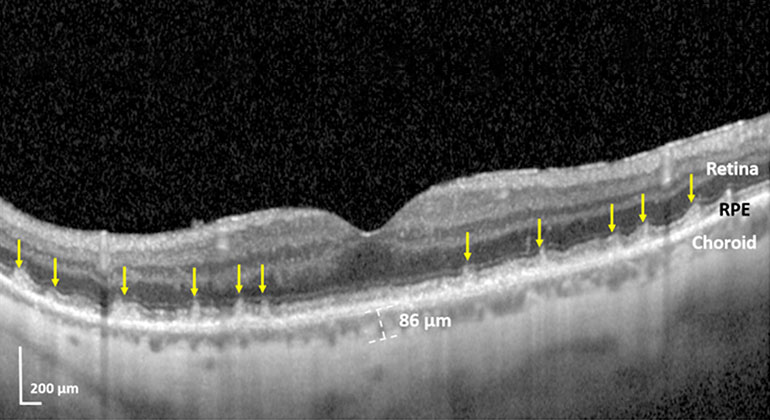High-Tech Imaging Offers New Way to Detect Signs of Early Glaucoma
Mount Sinai study shows flavoprotein fluorescence could serve as new biomarker

A new, non-invasive ocular imaging method may be able to detect an early indicator of glaucoma in time to prevent disease progression and vision loss, according to a new study from New York Eye and Ear Infirmary of Mount Sinai (NYEE). The study was published in the July/August issue of Ophthalmology Glaucoma.
The study focused on measuring flavoprotein fluorescence (FPF) in the eye. Mitochondria— which are responsible for generating energy in cells—produce FPF when they are stressed, and levels of FPF are elevated in people with glaucoma compared to those with normal eyes. Mitochondrial dysfunction in the optic nerve, which sends light signals to the brain and is critical for vision, can eventually lead to loss of cells and tissue damage, causing multiple eye diseases such as glaucoma, and macular degeneration, as well as other retinal damage. This is the first comprehensive study to look at FPF changes in the optic nerves in patients with different stages of glaucoma compared to healthy eyes.
“Glaucoma is difficult to diagnose in early stages, and often physicians agonize to confirm subtle signs of progression in advanced stages. Once structural damage to the optic nerve has occurred, it is currently not possible to reverse. The better we become at identifying early or ongoing degeneration, the more proactive we can be at implementing protective therapy,” says principal investigator Richard B. Rosen, MD, Vice Chair and Director of Ophthalmology Research at NYEE and Chief of the Retina Service for the Mount Sinai Health System. “Our study shows FPF may be useful as an objective measure for predicting glaucoma progression earlier than measuring structural damage, with similar sensitivity to visual field changes but easier and potentially more consistently.”
A team of researchers used the OcuMet Beacon—a fundus camera with special filters that specifically isolates the fluorescence, developed by OcuSciences Inc.—to analyze 86 eyes. Fifty of the eyes had glaucoma, based upon thinning of the retinal fiber layer, and 36 had no disease. They found FPF, an indicator of mitochondrial oxidative stress, was significantly higher in glaucoma eyes compared to normal eyes, especially in early-stage glaucoma cases where damage is difficult to detect. Levels of FPF correlated with other means of detecting glaucoma including visual field mean deviation, visual field pattern deviation, and retinal nerve fiber layer thickness.
These results suggest that FPF could be used clinically to reliably and objectively detect metabolic evidence of injury due to glaucoma, limiting the need for frequent visual field testing, the gold standard for measuring visual function. In fact, the researchers say, FPF may be a more accurate measurement, as visual fields have a number of downsides—they are subjective, fluctuate with a patient’s attention, and patients can lose concentration during this assessment.
“Previous studies have demonstrated that when the mitochondrial oxidative stress is relieved by medication or surgery, the flavoprotein fluorescence levels go down. This makes the technique very attractive as a sensitive way of monitoring response to therapy,” explains Dr. Rosen. “This measurement could potentially be used as a first-line indicator to monitor of glaucoma progression for the patient and the physician.”
Researchers say their next step is to see if FPF can reliably monitor the effect of therapy for glaucoma patients, to see when treatment has flattened the risk curve of progression in advanced cases, as well as identifying patients who require early glaucoma intervention.
About OcuSciences, Inc.
OcuSciences, Inc., is a clinical-stage biotechnology company developing the retinal imager, OcuMet Beacon, to identify metabolic dysfunction occurring in the retina for the early detection of disease. For more information visit www.OcuMet.com
About the Mount Sinai Health System
Mount Sinai Health System is one of the largest academic medical systems in the New York metro area, with 48,000 employees working across seven hospitals, more than 400 outpatient practices, more than 600 research and clinical labs, a school of nursing, and a leading school of medicine and graduate education. Mount Sinai advances health for all people, everywhere, by taking on the most complex health care challenges of our time—discovering and applying new scientific learning and knowledge; developing safer, more effective treatments; educating the next generation of medical leaders and innovators; and supporting local communities by delivering high-quality care to all who need it.
Through the integration of its hospitals, labs, and schools, Mount Sinai offers comprehensive health care solutions from birth through geriatrics, leveraging innovative approaches such as artificial intelligence and informatics while keeping patients’ medical and emotional needs at the center of all treatment. The Health System includes approximately 9,000 primary and specialty care physicians and 10 free-standing joint-venture centers throughout the five boroughs of New York City, Westchester, Long Island, and Florida. Hospitals within the System are consistently ranked by Newsweek’s® “The World’s Best Smart Hospitals, Best in State Hospitals, World Best Hospitals and Best Specialty Hospitals” and by U.S. News & World Report's® “Best Hospitals” and “Best Children’s Hospitals.” The Mount Sinai Hospital is on the U.S. News & World Report® “Best Hospitals” Honor Roll for 2025-2026.
For more information, visit https://www.mountsinai.org or find Mount Sinai on Facebook, Instagram, LinkedIn, X, and YouTube.

Blinding Eye Disease Strongly Associated With Serious Forms of Cardiovascular Disease
Nov 17, 2022 View All Press Releases
Blinding Eye Disease Is Strongly Associated With Heart Disease and Stroke
Jul 12, 2022 View All Press Releases